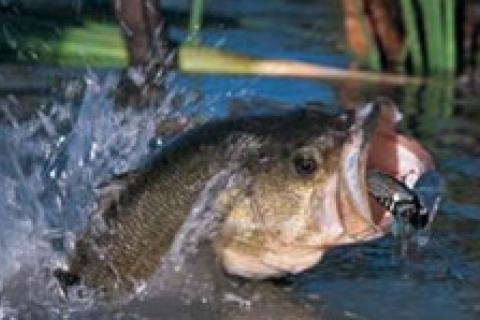
 Largemouth bass can be found in most lakes, rivers, streams and ponds across the continent. Due to their accessible nature and willingness to strike a wide range of lures, it's no wonder this feisty fish holds a treasured place in the hearts and minds of anglers everywhere.
Largemouth bass can be found in most lakes, rivers, streams and ponds across the continent. Due to their accessible nature and willingness to strike a wide range of lures, it's no wonder this feisty fish holds a treasured place in the hearts and minds of anglers everywhere.
Familiarizing yourself with the key structure areas largemouth bass reside in, why they are there, and how to easily recognize them on the lake, will help you put a bend in the rod and a fish in the net.
A Mixed Menu of Fish, Frog, and Crustacean
Largemouth bass will eat a wide variety of prey, but the top three choices would have to be baitfish (perch, bluegill, shad and minnows), crawfish and frogs. Due to the size of their cavernous mouths — hence the moniker "bucketmouth" — bass can eat prey up to half the size of their body length, and it's not uncommon to find a 10-inch perch or jumbo bullfrog inside the stomach cavities of this freshwater brawler.
The neat thing about largemouth bass is that you can catch them on a wide variety of lures, including plastics, topwaters, crankbaits and live bait.
Seek Out The Green Stuff
Although there are numerous places within a body of water where largemouth can be found, the most important ingredient for locating largemouth is aquatic vegetation (weeds).
Largemouth bass and weeds go hand-in-hand, and rarely will you find one without the other. Key vegetation to concentrate on would be lily pads, hydrilla, bulrushes, grasses and coontail. Bass use vegetation for a number of different reasons, namely shelter, protection and as an ambush point for capturing prey. (Weeds also attract many types of baitfish and other food sources, hence the presence of marauding bass.)
If you can find a mixture of more than one type of vegetation, the spot will often produce much better. And if that vegetation is found intermixed with other features such as wood, rock, undercut banks or sand, then your chances for success improve significantly.
The Lure of Slop
 |
| Overcast days will push laregemouth out from cover, oftentimes making them easier to locate and catch. |
'Slop" is another excellent vegetation to seek out. Amongst anglers, slop refers to any vegetation that congregates on the surface of the water, usually composed of a mixture of dying weeds or vegetation sliced up from outboard props. Depending on wind direction and the structure it butts up against, you will often find slop to be a gold mine. Largemouth will sit under this canopy of green stuff, waiting for bait to swim by, or amphibians to travel overhead. Weedless baits like hollow body frogs and Texas-rigged soft plastics will often trigger these fish to strike.
Look to the Sun
Light penetration is another important variable. As the sun reaches higher in the sky, largemouth will retreat from the open areas in order to bury in the weeds; searching out the cooler water that this shade provides. Anglers should target sparse weeds or open water during early morning and evening periods, and then move to thicker cover during midday when the sun is directly overhead.
The warmer and sunnier the day, the closer to cover bass will be found. It also goes without saying that cloudy or rainy days will pull bass further out from the weeds as they more actively roam in search of food during these low-light periods. Fast moving lures — spinnerbaits, buzzbaits, topwaters and jerkbaits — will account for the most fish during these aggressive periods.
Another important aspect to consider when searching for largemouth bass is their affinity for shallow water. Unlike their cousin the smallmouth bass, largemouth thrive in skinny water, meaning that 75 percent of your fishing will likely be done in water 10-feet deep or less. In fact, plenty of my time is concentrated on water that is between 2 and 6-feet deep. Sure, bass can be found in deeper water under certain conditions (cold fronts, post spawn, late fall and winter), but for my money, I'd have to bet on shallow water for coughing up the most fish on a consistent basis. Shore anglers can certainly excel by moving up and down a shoreline and looking for the features mentioned above.
Structure That Produces
A great way to put a bend in your rod is to always think of bass fishing as a game of hide-and-seek. Try to uncover the hidden fish and eventually you will find them. Here are some great structure points that produce.
- Boat Docks
- Stumps
- Logs and Fallen Trees
- Undercut Banks
- Bridge Pilings
Learning what habitat to look for when out on the water, while recognizing the diet of a largemouth bass, will help you better understand bass behaviour. It is this knowledge that will put fish in the boat. Think green, look to the sun and stay shallow. That is the recipe for bass success.
- 14153 views

